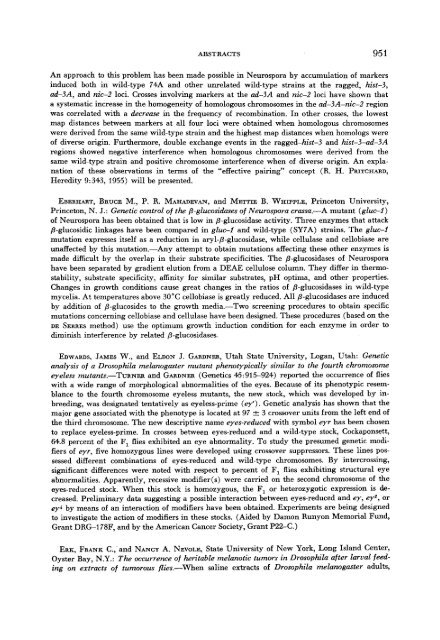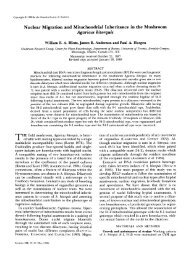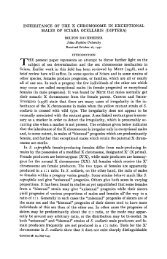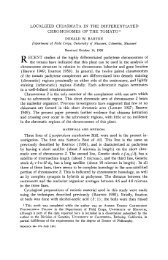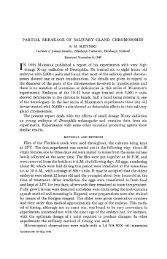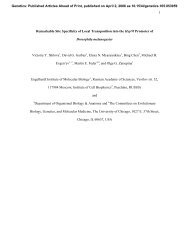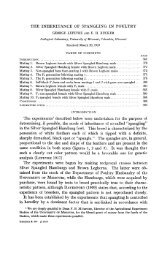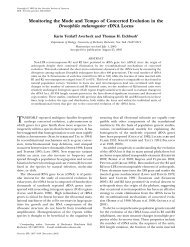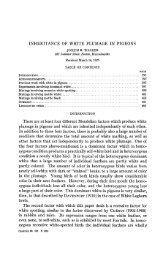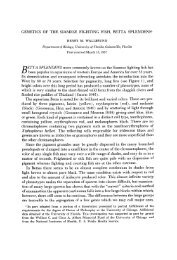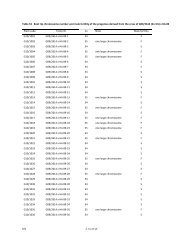abstracts of papers presented at the 1962 meetings - Genetics
abstracts of papers presented at the 1962 meetings - Genetics
abstracts of papers presented at the 1962 meetings - Genetics
You also want an ePaper? Increase the reach of your titles
YUMPU automatically turns print PDFs into web optimized ePapers that Google loves.
ABSTRACTS 95 1<br />
An approach to this problem has been made possible in Neurospora by accumul<strong>at</strong>ion <strong>of</strong> markers<br />
induced both in wild-type 74A and o<strong>the</strong>r unrel<strong>at</strong>ed wild-type strains <strong>at</strong> <strong>the</strong> ragged, hist-3,<br />
ad-3A, and nic-2 loci. Crosses involving markers <strong>at</strong> <strong>the</strong> ad-3A and nic-2 loci have shown th<strong>at</strong><br />
a system<strong>at</strong>ic increase in <strong>the</strong> homogeneity <strong>of</strong> homologous chromosomes in <strong>the</strong> ad-3A-nic-2 region<br />
was correl<strong>at</strong>ed with a decrease in <strong>the</strong> frequency <strong>of</strong> recombin<strong>at</strong>ion. In o<strong>the</strong>r crosses, <strong>the</strong> lowest<br />
map distances between markers <strong>at</strong> all four loci were obtained when homologous chromosomes<br />
were derived from <strong>the</strong> same wild-type strain and <strong>the</strong> highest map distances when homologs were<br />
<strong>of</strong> diverse origin. Fur<strong>the</strong>rmore, double exchange events in <strong>the</strong> ragged-hist-3 and hist-3-ad-3A<br />
regions showed neg<strong>at</strong>ive interference when homologous chromosomes were derived from <strong>the</strong><br />
same wild-type strain and positive chromosome interference when <strong>of</strong> diverse origin. An expla-<br />
n<strong>at</strong>ion <strong>of</strong> <strong>the</strong>se observ<strong>at</strong>ions in terms <strong>of</strong> <strong>the</strong> “effective pairing” concept (R. H. PRITCHARD,<br />
Heredity 9:343, 1955) will be <strong>presented</strong>.<br />
EBERHART, BRUCE M., P. R. MAHADEVAN, and METTIE B. WHIPPLE, Princeton University,<br />
Princeton, N. J.: Genetic control <strong>of</strong> <strong>the</strong> P-glucosidases <strong>of</strong> Neurospora crassa.-A mutant (gluc-I)<br />
<strong>of</strong> Neurospora has been obtained th<strong>at</strong> is low in P-glucosidase activity. Three enzymes th<strong>at</strong> <strong>at</strong>tack<br />
p-glucosidic linkages have been compared in gluc-i and wild-type (SY7A) strains. The gluc-1<br />
mut<strong>at</strong>ion expresses itself as a reduction in aryl-P-glucosidase, while cellulase and cellobiase are<br />
unaffected by this mut<strong>at</strong>ion.-Any <strong>at</strong>tempt to obtain mut<strong>at</strong>ions affecting <strong>the</strong>se o<strong>the</strong>r enzymes is<br />
made difficult by <strong>the</strong> overlap in <strong>the</strong>ir substr<strong>at</strong>e specificities. The P-glucosidases <strong>of</strong> Neurospora<br />
have been separ<strong>at</strong>ed by gradient elution from a DEAE cellulose column. They differ in <strong>the</strong>rmostability,<br />
substr<strong>at</strong>e specificity, affinity for similar substr<strong>at</strong>es, pH optima, and o<strong>the</strong>r properties.<br />
Changes in growth conditions cause gre<strong>at</strong> changes in <strong>the</strong> r<strong>at</strong>ios <strong>of</strong> P-glucosidases in wild-type<br />
mycelia. At temper<strong>at</strong>ures above 30°C cellobiase is gre<strong>at</strong>ly reduced. All P-glucosidases are induced<br />
by addition <strong>of</strong> p-glucosides to <strong>the</strong> growth media.--Two screening procedures to obtain specific<br />
mut<strong>at</strong>ions concerning cellobiase and cellulase have been designed. These procedures (based on <strong>the</strong><br />
DE SERRES method) use <strong>the</strong> optimum growth induction condition for each enzyme in order to<br />
diminish interference by rel<strong>at</strong>ed P-glucosidases.<br />
EDWARDS, JAMES W., and ELDON J. GARDNER, Utah St<strong>at</strong>e University, Logan, Utah: Genetic<br />
analysis <strong>of</strong> a Drosophila melanogaster mutant phenotypically similar to <strong>the</strong> fourth chromosome<br />
eyeless mutants.-TuRNm and GARDNER (<strong>Genetics</strong> 45: 915-924) reported <strong>the</strong> occurrence <strong>of</strong> flies<br />
with a wide range <strong>of</strong> morphological abnormalities <strong>of</strong> <strong>the</strong> eyes. Because <strong>of</strong> its phenotypic resemblance<br />
to <strong>the</strong> fourth chromosome eyeless mutants, <strong>the</strong> new stock, which was developed by inbreeding,<br />
was design<strong>at</strong>ed tent<strong>at</strong>ively as eyeless-prime (&). Genetic analysis has shown th<strong>at</strong> <strong>the</strong><br />
major gene associ<strong>at</strong>ed with <strong>the</strong> phenotype is loc<strong>at</strong>ed <strong>at</strong> 97 t 3 crossover units from <strong>the</strong> left end <strong>of</strong><br />
<strong>the</strong> third chromosome. The new descriptive name eyes-reduced with symbol eyr has been chosen<br />
to replace eyeless-prime. In crosses between eyes-reduced and a wild-type stock, Cockaponsett,<br />
64.8 percent <strong>of</strong> <strong>the</strong> F, flies exhibited an eye abnormality. To study <strong>the</strong> presumed genetic modifiers<br />
<strong>of</strong> eyr, five homozygous lines were developed using crossover suppressors. These lines possessed<br />
different combin<strong>at</strong>ions <strong>of</strong> eyes-reduced and wild-type chromosomes. By intercrossing,<br />
significant differences were noted with respect to percent <strong>of</strong> F, flies exhibiting structural eye<br />
abnormalities. Apparently, recessive modifier (s) were carried on <strong>the</strong> second chromosome <strong>of</strong> <strong>the</strong><br />
eyes-reduced stock. When this stock is homozygous, <strong>the</strong> F, or heterozygotic expression is decreased.<br />
Preliminary d<strong>at</strong>a suggesting a possible interaction between eyes-reduced and ey, eyz, or<br />
ey4 by means <strong>of</strong> an interaction <strong>of</strong> modifiers have been obtained. Experiments are being designed<br />
to investig<strong>at</strong>e <strong>the</strong> action <strong>of</strong> modifiers in <strong>the</strong>se stocks. (Aided by Damon Runyon Memorial Fund,<br />
Grant DRG-l78F, and by <strong>the</strong> American Cancer Society, Grant P22-C.)<br />
ERK, FRANK C., and NANCY A. NEVOLE, St<strong>at</strong>e University <strong>of</strong> New York, Long Island Center,<br />
Oyster Bay, N.Y.: The Occurrence <strong>of</strong> heritable melanotic tumors in Drosophila after larval feeding<br />
OR extracts <strong>of</strong> tumorous fZies.-When saline extracts <strong>of</strong> Drosophila melanogaster adults,


